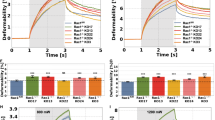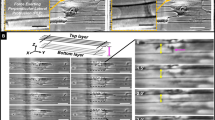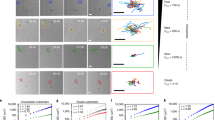Abstract
Cell elongation and polarization are basic morphogenetic responses to extracellular matrix adhesion. We demonstrate here that human cultured fibroblasts readily polarize when plated on rigid, but not on compliant, substrates. On rigid surfaces, large and uniformly oriented focal adhesions are formed, whereas cells plated on compliant substrates form numerous small and radially oriented adhesions. Live-cell monitoring showed that focal adhesion alignment precedes the overall elongation of the cell, indicating that focal adhesion orientation may direct cell polarization. siRNA-mediated knockdown of 85 human protein tyrosine kinases (PTKs) induced distinct alterations in the cell polarization response, as well as diverse changes in cell traction force generation and focal adhesion formation. Remarkably, changes in rigidity-dependent traction force development, or focal adhesion mechanosensing, were consistently accompanied by abnormalities in the cell polarization response. We propose that the different stages of cell polarization are regulated by multiple, PTK-dependent molecular checkpoints that jointly control cell contractility and focal-adhesion-mediated mechanosensing.
This is a preview of subscription content, access via your institution
Access options
Subscribe to this journal
Receive 12 print issues and online access
$209.00 per year
only $17.42 per issue
Buy this article
- Purchase on Springer Link
- Instant access to full article PDF
Prices may be subject to local taxes which are calculated during checkout





Similar content being viewed by others
References
Discher, D. E., Janmey, P. & Wang, Y. L. Tissue cells feel and respond to the stiffness of their substrate. Science 310, 1139–1143 (2005).
Geiger, B., Spatz, J. P. & Bershadsky, A. D. Environmental sensing through focal adhesions. Nat. Rev. Mol. Cell Biol. 10, 21–33 (2009).
Vogel, V. & Sheetz, M. Local force and geometry sensing regulate cell functions. Nat. Rev. Mol. Cell Biol. 7, 265–275 (2006).
Guilak, F. et al. Control of stem cell fate by physical interactions with the extracellular matrix. Cell Stem Cell 5, 17–26 (2009).
Janmey, P. A. & Miller, R. T. Mechanisms of mechanical signaling in development and disease. J. Cell Sci. 124, 9–18 (2011).
Orr, A. W., Helmke, B. P., Blackman, B. R. & Schwartz, M. A. Mechanisms of mechanotransduction. Dev. Cell 10, 11–20 (2006).
Vasiliev, J. M. Spreading of non-transformed and transformed cells. Biochim. Biophys. Acta 780, 21–65 (1985).
Petrie, R. J., Doyle, A. D. & Yamada, K. M. Random versus directionally persistent cell migration. Nat. Rev. Mol. Cell Biol. 10, 538–549 (2009).
Robinson, D. R., Wu, Y. M. & Lin, S. F. The protein tyrosine kinase family of the human genome. Oncogene 19, 5548–5557 (2000).
Cramer, L. P. Forming the cell rear first: breaking cell symmetry to trigger directed cell migration. Nat. Cell Biol. 12, 628–632 (2010).
Brunton, V. G., MacPherson, I. R. & Frame, M. C. Cell adhesion receptors, tyrosine kinases and actin modulators: a complex three-way circuitry. Biochim. Biophys. Acta 1692, 121–144 (2004).
Giannone, G. & Sheetz, M. P. Substrate rigidity and force define form through tyrosine phosphatase and kinase pathways. Trends Cell Biol. 16, 213–223 (2006).
Sawada, Y. et al. Force sensing by mechanical extension of the Src family kinase substrate p130Cas. Cell 127, 1015–1026 (2006).
Butler, J. P., Tolic-Norrelykke, I. M., Fabry, B. & Fredberg, J. J. Traction fields, moments, and strain energy that cells exert on their surroundings. Am. J. Phys. Cell Phys. 282, C595–C605 (2002).
Mitrossilis, D. et al. Single-cell response to stiffness exhibits muscle-like behavior. Proc. Natl Acad. Sci. USA 106, 18243–18248 (2009).
Saez, A. et al. Traction forces exerted by epithelial cell sheets. J. Phys. Condens. Matter 22, 194119 (2010).
Saez, A., Buguin, A., Silberzan, P. & Ladoux, B. Is the mechanical activity of epithelial cells controlled by deformations or forces? Biophys. J. 89, L52–L54 (2005).
Bershadsky, A. D., Balaban, N. Q. & Geiger, B. Adhesion-dependent cell mechanosensitivity. Annu. Rev. Cell Dev. Biol. 19, 677–695 (2003).
Puklin-Faucher, E. & Sheetz, M. P. The mechanical integrin cycle. J. Cell Sci. 122, 179–186 (2009).
Schwartz, M. A. & DeSimone, D. W. Cell adhesion receptors in mechanotransduction. Curr. Opin. Cell Biol. 20, 551–556 (2008).
Hoffman, B. D., Grashoff, C. & Schwartz, M. A. Dynamic molecular processes mediate cellular mechanotransduction. Nature 475, 316–323 (2011).
Goffin, J. M. et al. Focal adhesion size controls tension-dependent recruitment of alpha-smooth muscle actin to stress fibers. J. Cell Biol. 172, 259–268 (2006).
Stricker, J., Aratyn-Schaus, Y., Oakes, P. W. & Gardel, M. L. Spatiotemporal constraints on the force-dependent growth of focal adhesions. Biophys. J. 100, 2883–2893 (2011).
Fouchard, J., Mitrossilis, D. & Asnacios, A. Acto-myosin based response to stiffness and rigidity sensing. Cell. Adh. Migr. 5, 16–19 (2011).
Mitrossilis, D. et al. Real-time single-cell response to stiffness. Proc. Natl Acad. Sci. USA 107, 16518–16523 (2010).
Walcott, S. & Sun, S. X. A mechanical model of actin stress fiber formation and substrate elasticity sensing in adherent cells. Proc. Natl Acad. Sci. USA 107, 7757–7762 (2010).
Webster, K. D., Crow, A. & Fletcher, D. A. An AFM-based stiffness clamp for dynamic control of rigidity. PLoS One 6, e17807 (2011).
Montgomery, D. C. & Runger, G. C. Applied Statistics and Probability for Engineers 2nd edn (John Wiley, 1999).
Alexandrova, A. Y. et al. Comparative dynamics of retrograde actin flow and focal adhesions: formation of nascent adhesions triggers transition from fast to slow flow. PLoS One 3, e3234 (2008).
Choi, C. K. et al. Actin and α-actinin orchestrate the assembly and maturation of nascent adhesions in a myosin II motor-independent manner. Nat. Cell Biol. 10, 1039–1050 (2008).
Winograd-Katz, S. E., Itzkovitz, S., Kam, Z. & Geiger, B. Multiparametric analysis of focal adhesion formation by RNAi-mediated gene knockdown. J. Cell Biol. 186, 423–436 (2009).
Butler, J. P., Tolic-Norrelykke, I. M., Fabry, B. & Fredberg, J. J. Traction fields, moments, and strain energy that cells exert on their surroundings. Am. J. Phys. Cell Phys. 282, C595–C605 (2002).
Kam, Z., Zamir, E. & Geiger, B. Probing molecular processes in live cells by quantitative multidimensional microscopy. Trends Cell Biol. 11, 329–334 (2001).
Zamir, E. et al. Molecular diversity of cell-matrix adhesions. J. Cell Sci. 112 (Pt 11), 1655–1669 (1999).
Beeler, J. F., LaRochelle, W. J., Chedid, M., Tronick, S. R. & Aaronson, S. A. Prokaryotic expression cloning of a novel human tyrosine kinase. Mol. Cell Biol. 14, 982–988 (1994).
Vartiainen, M., Ojala, P. J., Auvinen, P., Peranen, J. & Lappalainen, P. Mouse A6/twinfilin is an actin monomer-binding protein that localizes to the regions of rapid actin dynamics. Mol. Cell Biol. 20, 1772–1783 (2000).
Acknowledgements
The authors are grateful to B. Morgenstern for expert help in preparing this article for publication. This work was financially supported, in part, by the National Institutes of Health (NIH) Common Fund Nanomedicine Program (PN2 EY016586), the Israel Science Foundation, the Minerva Foundation, the Maurice Janin Fund and the De Benedetti Foundation-Cherasco. B.G. holds the Erwin Neter Professorial Chair in Cell and Tumor Biology. A.D.B. holds the Joseph Moss Professorial Chair in Biomedical Research.
Author information
Authors and Affiliations
Contributions
M.P-K. and A.L. participated in the design of the experiments, carried them out and analysed the data. R.K. and K.R. carried out the traction force microscopy analysis. A.M. and Z.K. contributed to the microscopy analysis, image processing and statistical analysis of the data. A.D.B. and B.G. supervised the project and participated in all of its aspects, including its design, data analysis and manuscript preparation.
Corresponding authors
Ethics declarations
Competing interests
The authors declare no competing financial interests.
Supplementary information
Supplementary Information
Supplementary Information (PDF 431 kb)
Supplementary Table 1
Supplementary Information (XLS 60 kb)
Supplementary Table 2
Supplementary Information (XLS 21 kb)
Supplementary Movie 1
Supplementary Information (MOV 61799 kb)
Supplementary Movie 2
Supplementary Information (MOV 16561 kb)
Supplementary Movie 3
Supplementary Information (MOV 388 kb)
Rights and permissions
About this article
Cite this article
Prager-Khoutorsky, M., Lichtenstein, A., Krishnan, R. et al. Fibroblast polarization is a matrix-rigidity-dependent process controlled by focal adhesion mechanosensing. Nat Cell Biol 13, 1457–1465 (2011). https://doi.org/10.1038/ncb2370
Received:
Accepted:
Published:
Issue Date:
DOI: https://doi.org/10.1038/ncb2370
This article is cited by
-
Fibroblast and myofibroblast activation in normal tissue repair and fibrosis
Nature Reviews Molecular Cell Biology (2024)
-
Pathological mechanisms of cold and mechanical stress in modulating cancer progression
Human Cell (2024)
-
Field Guide to Traction Force Microscopy
Cellular and Molecular Bioengineering (2024)
-
Hydrogel-based molecular tension fluorescence microscopy for investigating receptor-mediated rigidity sensing
Nature Methods (2023)
-
Genetics and mechanisms of thoracic aortic disease
Nature Reviews Cardiology (2023)



